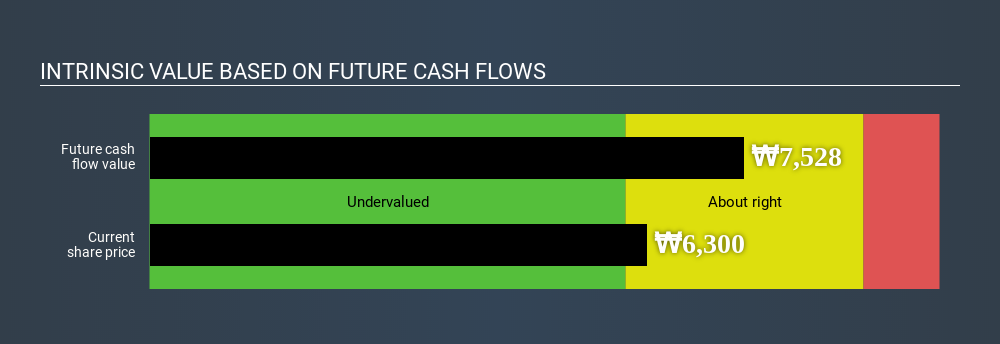- South Korea
- /
- Communications
- /
- KOSDAQ:A040160
Calculating The Intrinsic Value Of Nuri Telecom Co., Ltd. (KOSDAQ:040160)

In this article we are going to estimate the intrinsic value of Nuri Telecom Co., Ltd. (KOSDAQ:040160) by taking the expected future cash flows and discounting them to their present value. I will use the Discounted Cash Flow (DCF) model. Don't get put off by the jargon, the math behind it is actually quite straightforward.
Remember though, that there are many ways to estimate a company's value, and a DCF is just one method. If you want to learn more about discounted cash flow, the rationale behind this calculation can be read in detail in the Simply Wall St analysis model.
Check out our latest analysis for Nuri Telecom
Crunching the numbers
We use what is known as a 2-stage model, which simply means we have two different periods of growth rates for the company's cash flows. Generally the first stage is higher growth, and the second stage is a lower growth phase. To start off with, we need to estimate the next ten years of cash flows. Seeing as no analyst estimates of free cash flow are available to us, we have extrapolate the previous free cash flow (FCF) from the company's last reported value. We assume companies with shrinking free cash flow will slow their rate of shrinkage, and that companies with growing free cash flow will see their growth rate slow, over this period. We do this to reflect that growth tends to slow more in the early years than it does in later years.
A DCF is all about the idea that a dollar in the future is less valuable than a dollar today, and so the sum of these future cash flows is then discounted to today's value:
10-year free cash flow (FCF) estimate
| 2020 | 2021 | 2022 | 2023 | 2024 | 2025 | 2026 | 2027 | 2028 | 2029 | |
| Levered FCF (₩, Millions) | ₩6.80b | ₩6.96b | ₩7.16b | ₩7.39b | ₩7.64b | ₩7.90b | ₩8.19b | ₩8.49b | ₩8.81b | ₩9.14b |
| Growth Rate Estimate Source | Est @ 1.82% | Est @ 2.43% | Est @ 2.86% | Est @ 3.16% | Est @ 3.37% | Est @ 3.52% | Est @ 3.62% | Est @ 3.69% | Est @ 3.74% | Est @ 3.78% |
| Present Value (₩, Millions) Discounted @ 12% | ₩6.1k | ₩5.6k | ₩5.2k | ₩4.8k | ₩4.4k | ₩4.1k | ₩3.8k | ₩3.5k | ₩3.3k | ₩3.1k |
("Est" = FCF growth rate estimated by Simply Wall St)
Present Value of 10-year Cash Flow (PVCF) = ₩44b
After calculating the present value of future cash flows in the initial 10-year period, we need to calculate the Terminal Value, which accounts for all future cash flows beyond the first stage. The Gordon Growth formula is used to calculate Terminal Value at a future annual growth rate equal to the 10-year government bond rate of 3.9%. We discount the terminal cash flows to today's value at a cost of equity of 12%.
Terminal Value (TV)= FCF2029 × (1 + g) ÷ (r – g) = ₩9.1b× (1 + 3.9%) ÷ 12%– 3.9%) = ₩123b
Present Value of Terminal Value (PVTV)= TV / (1 + r)10= ₩123b÷ ( 1 + 12%)10= ₩41b
The total value is the sum of cash flows for the next ten years plus the discounted terminal value, which results in the Total Equity Value, which in this case is ₩85b. In the final step we divide the equity value by the number of shares outstanding. Compared to the current share price of ₩6.3k, the company appears about fair value at a 17% discount to where the stock price trades currently. Valuations are imprecise instruments though, rather like a telescope - move a few degrees and end up in a different galaxy. Do keep this in mind.

Important assumptions
Now the most important inputs to a discounted cash flow are the discount rate, and of course, the actual cash flows. If you don't agree with these result, have a go at the calculation yourself and play with the assumptions. The DCF also does not consider the possible cyclicality of an industry, or a company's future capital requirements, so it does not give a full picture of a company's potential performance. Given that we are looking at Nuri Telecom as potential shareholders, the cost of equity is used as the discount rate, rather than the cost of capital (or weighted average cost of capital, WACC) which accounts for debt. In this calculation we've used 12%, which is based on a levered beta of 1.116. Beta is a measure of a stock's volatility, compared to the market as a whole. We get our beta from the industry average beta of globally comparable companies, with an imposed limit between 0.8 and 2.0, which is a reasonable range for a stable business.
Next Steps:
Valuation is only one side of the coin in terms of building your investment thesis, and it shouldn’t be the only metric you look at when researching a company. The DCF model is not a perfect stock valuation tool. Rather it should be seen as a guide to "what assumptions need to be true for this stock to be under/overvalued?" If a company grows at a different rate, or if its cost of equity or risk free rate changes sharply, the output can look very different. For Nuri Telecom, We've compiled three important aspects you should further examine:
- Risks: Take risks, for example - Nuri Telecom has 3 warning signs we think you should be aware of.
- Other High Quality Alternatives: Do you like a good all-rounder? Explore our interactive list of high quality stocks to get an idea of what else is out there you may be missing!
- Other Top Analyst Picks: Interested to see what the analysts are thinking? Take a look at our interactive list of analysts' top stock picks to find out what they feel might have an attractive future outlook!
PS. The Simply Wall St app conducts a discounted cash flow valuation for every stock on the KOSDAQ every day. If you want to find the calculation for other stocks just search here.
Love or hate this article? Concerned about the content? Get in touch with us directly. Alternatively, email editorial-team@simplywallst.com.
This article by Simply Wall St is general in nature. It does not constitute a recommendation to buy or sell any stock, and does not take account of your objectives, or your financial situation. We aim to bring you long-term focused analysis driven by fundamental data. Note that our analysis may not factor in the latest price-sensitive company announcements or qualitative material. Simply Wall St has no position in any stocks mentioned. Thank you for reading.
About KOSDAQ:A040160
NuriFlexLtd
Provides optimal IoT solutions for utilities, manufacturing, energy, and public sector in South Korea and internationally.
Adequate balance sheet low.
Market Insights
Community Narratives



